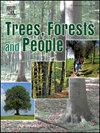Palmyrah (Borassus flabellifer) palm land-use system: A potential key tool for enhancing carbon stock and floristic diversity in a dry zone tropical landscape
IF 2.7
Q1 FORESTRY
引用次数: 0
Abstract
The threat of global warming, biodiversity loss, and land degradation highlight the urgency of identifying sustainable land use systems that serve as climate-adaptive solutions. This study assessed the carbon stock and floristic diversity of the Borassus flabellifer (Palmyrah palm) land uses under 14 different soil series in the Jaffna district of Sri Lanka. A total of 75 sampling quadrats (10 m × 10 m) were surveyed, collecting data on the number of Palmyrah palms and other flora species and, the height. Soil samples were collected at three depths (0–10 cm, 10–20 cm, and 20–30 cm) for organic carbon analysis. Carbon stock in biomass was estimated using standard allometric equations, and total carbon stock was calculated by summing biomass (above-ground and below-ground) and soil carbon. The study found that soil organic carbon percentage of surface layer (0 – 30 cm) in different soil series ranged from 0.31 to 1.61 %. The topmost layer (0 – 10 cm) had higher average soil organic carbon stock (12.25 Mg C ha-1) than sub surface layers (10 – 20 cm – 11.57 Mg C ha-1), 20 – 30 cm – 10.11 Mg C ha-1). A total of 22 floral species belonging to 13 families were identified in the surveyed quadrats. Shannan Weaver index (SWI) and the evenness were 1.2 and 0.74, respectively indicating moderate biodiversity levels. The average values of Palmyrah palm density, biomass carbon stock, soil carbon stock, and total carbon stock were 914 ± 179 stems ha-1, 72.48 ± 15.11 Mg C ha-1, 36.05 ± 15.81 Mg C ha-1, and 108.53 ± 21.47 Mg C ha-1, respectively. These findings highlight Palmyrah palm land use as a significant carbon sink with substantial potential for biodiversity conservation. Promoting this land use system could contribute to sustainable climate mitigation and adaptation strategies in regions facing similar ecological challenges.
棕榈土地利用系统:一个潜在的增强热带干旱区碳储量和植物多样性的关键工具
全球变暖、生物多样性丧失和土地退化的威胁凸显了确定可持续土地利用系统作为气候适应解决方案的紧迫性。本研究评估了斯里兰卡贾夫纳地区14种不同土壤类型下棕榈土地利用的碳储量和植物区系多样性。调查共75个样方(10 m × 10 m),收集了棕榈和其他植物种类的数量、高度等数据。在0-10 cm、10-20 cm和20-30 cm三个深度采集土壤样品进行有机碳分析。利用标准异速生长方程估算生物量碳储量,利用生物量(地上和地下)与土壤碳的总和计算总碳储量。研究发现,不同土壤系列的表层(0 ~ 30 cm)土壤有机碳百分比在0.31% ~ 1.61%之间。最表层(0 ~ 10 cm)土壤平均有机碳储量(12.25 Mg C ha-1)高于次表层(10 ~ 20 cm - 11.57 Mg C ha-1)和20 ~ 30 cm - 10.11 Mg C ha-1)。调查样方共鉴定出13科22种花卉。山南韦弗指数(SWI)为1.2,均匀度为0.74,属于中等生物多样性水平。棕榈密度、生物量碳储量、土壤碳储量和总碳储量的平均值分别为914±179 Mg C ha-1、72.48±15.11 Mg C ha-1、36.05±15.81 Mg C ha-1和108.53±21.47 Mg C ha-1。这些发现强调了棕榈土地利用是一个重要的碳汇,具有巨大的生物多样性保护潜力。在面临类似生态挑战的地区,推广这种土地利用制度可以促进可持续的气候减缓和适应战略。
本文章由计算机程序翻译,如有差异,请以英文原文为准。
求助全文
约1分钟内获得全文
求助全文
来源期刊

Trees, Forests and People
Economics, Econometrics and Finance-Economics, Econometrics and Finance (miscellaneous)
CiteScore
4.30
自引率
7.40%
发文量
172
审稿时长
56 days
 求助内容:
求助内容: 应助结果提醒方式:
应助结果提醒方式:


